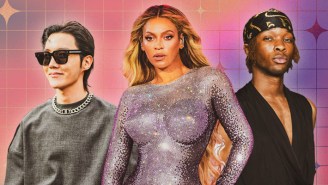(If you haven’t seen Captain America: Civil War, but you have read the title of this post and don’t think there will be Captain America: Civil War spoilers ahead, well this is all on you at this point. To make clear, there are spoilers ahead.)
Even if you haven’t seen Captain America: Civil War (if you haven’t, why are you reading this?!?!), we all know that Captain America and Iron Man fight. It’s in every commercial. But just why they are fighting is a little more surprising. Yes, there are those U.N. accords that Tony Stark and Steve Rogers disagree over, but by the time the final fight happens, Tony and Steve had put aside their differences.
That’s where Daniel Brühl’s Helmut Zemo, whose been pulling strings the whole movie, comes into play. Ahead, the Captain America: Civil War writers, Christopher Markus and Stephen McFeely, explain just what movie inspired their ending and what character they found the toughest to incorporate into this story. But first, why did the writers need a character like Zemo?
“We wanted to leave them shattered before Infinity War,” explains McFeely. He continues, “When it’s ‘civil war,’ and when Stark is pretty much going to be the antagonist – even though he’s not the ‘villain’ by any stretch – that’s the lion’s share of the story. So, when you have to have a third plot, a ‘c’ plot, where someone else is pulling strings for different reasons, that’s going to be subtle and it’s going to be quiet and it’s going to lead to a thing in the third act.”
In a crucial scene, Zemo taunts Tony and Steve, basically explaining to them how he’s going to force them to fight. Both Tony and Steve think Zemo is nuts, why would they possibly fight at this point? But then Zemo shows Tony a videotape (and since you’ve seen the movie, you know what’s on that tape), that does in fact turn the two friends into enemies. Yeah, this has a whole “What’s in the box?” feel to it. (A movie that obviously stars Gwyneth Paltrow, who doesn’t appear in Civil War, but is a big part of the Marvel Cinematic Universe already.) And, nope, that’s not a coincidence.
“Our model for that part was Se7en,” says McFeely. “When we get to the video at the end and we see the footage of the crash, we want that to be ‘what’s in the box?’ and have this really awful moment. Whether you like the movie or not is really if you buy into that or not. So because we couldn’t have a villain written large, that means all of our characters are being manipulated. And it’s more important to us the events of the previous 13 movies are the reason we’re having this argument, not because someone is pulling our strings.”
And with all this going on, which character was the most difficult to implement into this? As it turns out, it was Black Widow.
Stephen Markus explains, “Black Widow was tough to nuance. In that, we knew we wanted her to kind of play the middle, but not in a duplicitous way.”
McFeely continues, “We hit upon the idea that forcing her to be the face of the accords – she goes to Vienna and has all of those scenes with Black Panther – it’s an uncomfortable thing for her, but a natural progression of the four movies she’s been in before. She’s a woman who came from the shadows and with every decision has invested in this family and is now watching that family break apart. And by the end, she realizes she’s chosen the wrong side. And we’ve always knew we wanted someone to turn, like Spider-Man does in the comic, but we knew it would never be Spider-Man because we don’t have him for that – too much heavy lifting to go from one to the other. But her you could do and she’s a great actress. And we wanted to surprise people. I think a lot of people assumed she’d be on Steve’s side. We have to earn it, but we like surprises.”
Mike Ryan lives in New York City and has written for The Huffington Post, Wired, Vanity Fair and New York magazine. He is senior entertainment writer at Uproxx. You can contact him directly on Twitter.






